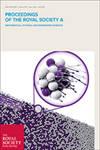压力诱导的a - e相变是否发生在所有低合金钢中?
Proceedings of the Royal Society of London. Series A. Mathematical and Physical Sciences
Pub Date : 2004-10-08
DOI:10.1098/rspa.2004.1314
引用次数: 13
摘要
在设计许多产品,特别是车辆时,考虑冲击性能是很重要的。本文给出了两个贝氏体钢实例的基本动态数据。报告了纵向应力对剪切强度的影响。这两种材料的数值相似,与低碳钢的数值一致。低温贝氏体中的铁素体在13gpa时发生了激波诱导的相变,而上层贝氏体中没有发生相变。进一步的研究正在通过研究微观结构和冲击对其的影响来解释这种差异。发现低温贝氏体表现为脆性,极度破碎,而上部贝氏体样品通常完好无损,表明韧性行为。还测量了这些材料在一系列冲击条件下的动态拉伸或剥落强度。对于上贝氏体,随着纵向应力的增加,剥落强度略有下降。然而,对于温度较低的贝氏体,在发生相变的纵向应力以上,小块强度明显下降。还进行了微观结构研究。本文章由计算机程序翻译,如有差异,请以英文原文为准。
Does the pressure‐induced a‐e phase transition occur for all low–alloy steels?
When designing many products, especially vehicles, it is important to take into consideration impact properties. This paper presents fundamental dynamic data for two examples of bainitic steels. Hugoniots and shear–strength variation with longitudinal stress is reported. These were similar for both materials and in agreement with values for mild steel. The ferrite in the lower–temperature bainite was found to undergo a shock–induced phase transition at 13 GPa, whereas no phase transition was observed in the upper bainite. Further research is being conducted to account for this difference by studying the microstructure and the effect of impact on it. The lower–temperature bainite was found to behave in a brittle fashion, fragmenting extremely, whereas upper bainitic samples were usually recovered intact indicating ductile behaviour. The dynamic tensile or spall strength was also measured in these materials over a range of impact conditions. For the upper bainite, the spall strength dropped slightly with increasing longitudinal stress. However, for the lower–temperature bainite, there was a significant drop in spall strength above the longitudinal stress at which the phase transition occurs. Microstructural studies were also undertaken.
求助全文
通过发布文献求助,成功后即可免费获取论文全文。
去求助
来源期刊
自引率
0.00%
发文量
0
期刊介绍:
Proceedings A publishes articles across the chemical, computational, Earth, engineering, mathematical, and physical sciences. The articles published are high-quality, original, fundamental articles of interest to a wide range of scientists, and often have long citation half-lives. As well as established disciplines, we encourage emerging and interdisciplinary areas.

 求助内容:
求助内容: 应助结果提醒方式:
应助结果提醒方式:


